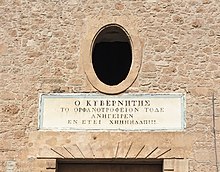Attic numerals


The Attic
The Attic numerals were a decimal (base 10) system, like the older
Attic numerals were adopted possibly starting in the 7th century BCE and although presently called Attic, they or variations thereof were universally used by the Greeks. No other
The system
Symbols
The Attic numerals used the following main symbols, with the given values:[1][2]
The symbols representing 50, 500, 5000, and 50000 were composites of an old form of the capital letter pi (with a short right leg) and a tiny version of the applicable power of ten. For example, 𐅆 was five times one thousand.
Special symbols
The fractions "one half" and "one quarter" were written "𐅁" and "𐅀", respectively.
The symbols were slightly modified when used to encode amounts in talents (with a small capital tau, "Τ") or in staters (with a small capital sigma, "Σ"). Specific numeral symbols were used to represent one drachma ("𐅂") and ten minas "𐅗".
The symbol for 100
The use of "Η" (capital
Simple multiples of powers of ten
Multiples 1 to 9 of each power of ten were written by combining the two corresponding "1" and "5" digits, namely:
| Units | Ι | II | III | IIII | Π | ΠI | ΠII | ΠIII | ΠIIII |
| 1 | 2 | 3 | 4 | 5 | 6 | 7 | 8 | 9 | |
| Tens | Δ | ΔΔ | ΔΔΔ | ΔΔΔΔ | 𐅄 | 𐅄Δ | 𐅄ΔΔ | 𐅄ΔΔΔ | 𐅄ΔΔΔΔ |
| 10 | 20 | 30 | 40 | 50 | 60 | 70 | 80 | 90 | |
| Hundreds | Η | ΗΗ | ΗΗΗ | ΗΗΗΗ | 𐅅 | 𐅅Η | 𐅅ΗΗ | 𐅅ΗΗΗ | 𐅅ΗΗΗΗ |
| 100 | 200 | 300 | 400 | 500 | 600 | 700 | 800 | 900 | |
| Thousands | Χ | ΧΧ | ΧΧΧ | ΧΧΧΧ | 𐅆 | 𐅆Χ | 𐅆ΧΧ | 𐅆ΧΧΧ | 𐅆ΧΧΧΧ |
| 1000 | 2000 | 3000 | 4000 | 5000 | 6000 | 7000 | 8000 | 9000 | |
| Tens of thousands | Μ | ΜΜ | ΜΜΜ | ΜΜΜΜ | 𐅇 | 𐅇Μ | 𐅇ΜΜ | 𐅇ΜΜΜ | 𐅇ΜΜΜΜ |
| 10000 | 20000 | 30000 | 40000 | 50000 | 60000 | 70000 | 80000 | 90000 | |
Unlike the more familiar Roman numeral system, the Attic system used only the so-called "additive" notation. Thus, the numbers 4 and 9 were written ΙΙΙΙ and ΠΙΙΙΙ, not ΙΠ and ΙΔ.
General numbers
In general, the number to be represented was broken down into simple multiples (1 to 9) of powers of ten — units, tens, hundred, thousands, etc.. Then these parts would be written down in sequence, from largest to smallest value. For example:
- 49 = 40 + 9 = ΔΔΔΔ + ΠΙΙΙΙ = ΔΔΔΔΠΙΙΙΙ
- 2001 = 2000 + 1 = ΧΧ + I = ΧΧΙ
- 1982 = 1000 + 900 + 80 + 2 = Χ + 𐅅ΗΗΗΗ + 𐅄ΔΔΔ + ΙΙ = Χ𐅅ΗΗΗΗ𐅄ΔΔΔΙΙ
- 62708 = 60000 + 2000 + 700 + 8 = 𐅇Μ + ΧΧ + 𐅅ΗΗ + ΠΙΙΙ = 𐅇ΜΧΧ𐅅ΗΗΠΙΙΙ.
Unicode
| Ancient Greek Numbers[1][2] Official Unicode Consortium code chart (PDF) | ||||||||||||||||
| 0 | 1 | 2 | 3 | 4 | 5 | 6 | 7 | 8 | 9 | A | B | C | D | E | F | |
| U+1014x | 𐅀 | 𐅁 | 𐅂 | 𐅃 | 𐅄 | 𐅅 | 𐅆 | 𐅇 | 𐅈 | 𐅉 | 𐅊 | 𐅋 | 𐅌 | 𐅍 | 𐅎 | 𐅏 |
| U+1015x | 𐅐 | 𐅑 | 𐅒 | 𐅓 | 𐅔 | 𐅕 | 𐅖 | 𐅗 | 𐅘 | 𐅙 | 𐅚 | 𐅛 | 𐅜 | 𐅝 | 𐅞 | 𐅟 |
| U+1016x | 𐅠 | 𐅡 | 𐅢 | 𐅣 | 𐅤 | 𐅥 | 𐅦 | 𐅧 | 𐅨 | 𐅩 | 𐅪 | 𐅫 | 𐅬 | 𐅭 | 𐅮 | 𐅯 |
| U+1017x | 𐅰 | 𐅱 | 𐅲 | 𐅳 | 𐅴 | 𐅵 | 𐅶 | 𐅷 | 𐅸 | 𐅹 | 𐅺 | 𐅻 | 𐅼 | 𐅽 | 𐅾 | 𐅿 |
| U+1018x | 𐆀 | 𐆁 | 𐆂 | 𐆃 | 𐆄 | 𐆅 | 𐆆 | 𐆇 | 𐆈 | 𐆉 | 𐆊 | 𐆋 | 𐆌 | 𐆍 | 𐆎 | |
| Notes | ||||||||||||||||
| Part of a series on |
| Numeral systems |
|---|
| List of numeral systems |
See also
- Etruscan numerals – words and phrases for numbers of the Etruscan language
- Greek mathematics – Mathematics of Ancient Greeks
- Greek numerals
- History of ancient numeral systems – Symbols representing numbers
- List of numeral system topics
- List of numeral systems
Notes and references
- ^ a b Gow, James (1883). "The Greek numerical alphabet". The Journal of Philology. XXII. Cambridge: 278–9.
- ^ ISBN 9780486204307.
- ISBN 0-521-23188-4.
- ISBN 0-674-36250-0.
- Standard Modern Greek, resulting in the standard modern spelling εκατό.
